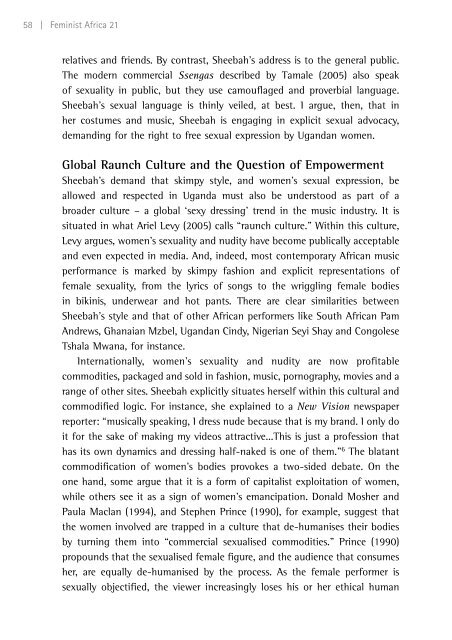The politics of fashion and beauty in Africa
fa21_proof_3
fa21_proof_3
You also want an ePaper? Increase the reach of your titles
YUMPU automatically turns print PDFs into web optimized ePapers that Google loves.
58 | Fem<strong>in</strong>ist <strong>Africa</strong> 21<br />
relatives <strong>and</strong> friends. By contrast, Sheebah’s address is to the general public.<br />
<strong>The</strong> modern commercial Ssengas described by Tamale (2005) also speak<br />
<strong>of</strong> sexuality <strong>in</strong> public, but they use camouflaged <strong>and</strong> proverbial language.<br />
Sheebah’s sexual language is th<strong>in</strong>ly veiled, at best. I argue, then, that <strong>in</strong><br />
her costumes <strong>and</strong> music, Sheebah is engag<strong>in</strong>g <strong>in</strong> explicit sexual advocacy,<br />
dem<strong>and</strong><strong>in</strong>g for the right to free sexual expression by Ug<strong>and</strong>an women.<br />
Global Raunch Culture <strong>and</strong> the Question <strong>of</strong> Empowerment<br />
Sheebah’s dem<strong>and</strong> that skimpy style, <strong>and</strong> women’s sexual expression, be<br />
allowed <strong>and</strong> respected <strong>in</strong> Ug<strong>and</strong>a must also be understood as part <strong>of</strong> a<br />
broader culture – a global ‘sexy dress<strong>in</strong>g’ trend <strong>in</strong> the music <strong>in</strong>dustry. It is<br />
situated <strong>in</strong> what Ariel Levy (2005) calls “raunch culture.” With<strong>in</strong> this culture,<br />
Levy argues, women’s sexuality <strong>and</strong> nudity have become publically acceptable<br />
<strong>and</strong> even expected <strong>in</strong> media. And, <strong>in</strong>deed, most contemporary <strong>Africa</strong>n music<br />
performance is marked by skimpy <strong>fashion</strong> <strong>and</strong> explicit representations <strong>of</strong><br />
female sexuality, from the lyrics <strong>of</strong> songs to the wriggl<strong>in</strong>g female bodies<br />
<strong>in</strong> bik<strong>in</strong>is, underwear <strong>and</strong> hot pants. <strong>The</strong>re are clear similarities between<br />
Sheebah’s style <strong>and</strong> that <strong>of</strong> other <strong>Africa</strong>n performers like South <strong>Africa</strong>n Pam<br />
Andrews, Ghanaian Mzbel, Ug<strong>and</strong>an C<strong>in</strong>dy, Nigerian Seyi Shay <strong>and</strong> Congolese<br />
Tshala Mwana, for <strong>in</strong>stance.<br />
Internationally, women’s sexuality <strong>and</strong> nudity are now pr<strong>of</strong>itable<br />
commodities, packaged <strong>and</strong> sold <strong>in</strong> <strong>fashion</strong>, music, pornography, movies <strong>and</strong> a<br />
range <strong>of</strong> other sites. Sheebah explicitly situates herself with<strong>in</strong> this cultural <strong>and</strong><br />
commodified logic. For <strong>in</strong>stance, she expla<strong>in</strong>ed to a New Vision newspaper<br />
reporter: “musically speak<strong>in</strong>g, I dress nude because that is my br<strong>and</strong>. I only do<br />
it for the sake <strong>of</strong> mak<strong>in</strong>g my videos attractive...This is just a pr<strong>of</strong>ession that<br />
has its own dynamics <strong>and</strong> dress<strong>in</strong>g half-naked is one <strong>of</strong> them.” 6 <strong>The</strong> blatant<br />
commodification <strong>of</strong> women’s bodies provokes a two-sided debate. On the<br />
one h<strong>and</strong>, some argue that it is a form <strong>of</strong> capitalist exploitation <strong>of</strong> women,<br />
while others see it as a sign <strong>of</strong> women’s emancipation. Donald Mosher <strong>and</strong><br />
Paula Maclan (1994), <strong>and</strong> Stephen Pr<strong>in</strong>ce (1990), for example, suggest that<br />
the women <strong>in</strong>volved are trapped <strong>in</strong> a culture that de-humanises their bodies<br />
by turn<strong>in</strong>g them <strong>in</strong>to “commercial sexualised commodities.” Pr<strong>in</strong>ce (1990)<br />
propounds that the sexualised female figure, <strong>and</strong> the audience that consumes<br />
her, are equally de-humanised by the process. As the female performer is<br />
sexually objectified, the viewer <strong>in</strong>creas<strong>in</strong>gly loses his or her ethical human



